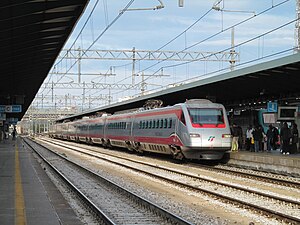
Milano Centrale is the main railway station of the city of Milan, Italy, and is the second railway station in Italy for passenger flow and the largest railway station in Europe by volume.

Bologna Centrale is the main railway station in Bologna, Italy. The station is situated at the northern edge of the city centre. It is located at the southern end of the Milan-Bologna high-speed line, which opened on 13 December 2008, and the northern end of three lines between Bologna and Florence: the original Bologna-Florence line through Porretta Terme and Pistoia; the Bologna–Florence Direttissima via Prato, which opened on 22 April 1934 and the Bologna-Florence high-speed line, which opened to traffic on 13 December 2009.
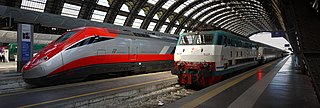
The Italian railway system is one of the most important parts of the infrastructure of Italy, with a total length of 24,227 km (15,054 mi) of which active lines are 16,723 km (10,391 mi). The network has recently grown with the construction of the new high-speed rail network. Italy is a member of the International Union of Railways (UIC). The UIC Country Code for Italy is 83.
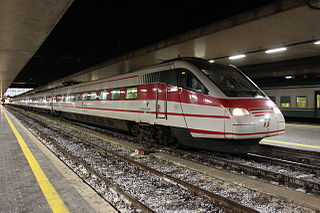
Eurostar Italia was the name given to high-speed trains operated by Trenitalia in Italy. The brand was discontinued and replaced with Le Frecce in December 2012.

Roma Termini is the main railway station of Rome, Italy. It is named after the district of the same name, which in turn took its name from ancient Baths of Diocletian, which lies across the street from the main entrance. It is Italy's busiest railway station and the fifth-busiest in Europe, with a traffic volume of approximately 150 million passengers per year, and with 850 trains in transit per day.
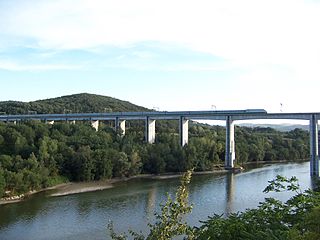
High-speed rail in Italy consists of two lines connecting most of the country's major cities. The first line connects Turin to Salerno via Milan, Bologna, Florence, Rome and Naples, the second runs from Turin to Venice via Milan and Verona, and is under construction in parts. Trains are operated with a top speed of 300 km/h (190 mph).

Napoli Centrale is the main railway station in the city of Naples and in southern Italy and the sixth largest station in Italy in terms of passenger flow with an annual ridership of 50 million. It is located next to Piazza Garibaldi to the east of the old city. It is the primary rail terminus and station for Naples, and serves Trenitalia national railways and EAV. This one has an underground section known as Stazione di Napoli Piazza Garibaldi, which is served by the metropolitan trains of the line 2, line 1 (Garibaldi), and 3, 12, 14, and 15 EAV Circumvesuviana lines which is accessible from 2 entrances inside the Centrale station, 1 outside in glass, and from the new Garibaldi Square.

Salerno railway station serves the Italian city of Salerno and was opened in 1866. It is the main railway station of the city.

Torino Porta Susa is a railway station in Turin, northern Italy; it is the second busiest mainline station in the city, after Torino Porta Nuova. It is located in Corso Inghilterra.

Torino Porta Nuova railway station is the main railway station of Turin, northern Italy. It is the third busiest station in Italy after Rome Termini and Milan Central, with about 192,000 journeys per day and 70 million travellers a year and a total of about 350 trains per day. Porta Nuova is a terminal station, with trains arriving perpendicularly to the facade. The station is located in Corso Vittorio Emanuele II, right in front of Piazza Carlo Felice.

Parma is a railway station serving the city of Parma, in the region of Emilia-Romagna, northern Italy. The station opened in 1859 and is located on the Milan–Bologna railway, Pontremolese railway, Brescia–Parma railway and Parma–Suzzara railway. The train services are operated by Trenitalia, Trenord and Ferrovie Emilia Romagna.

Frecciarossa is a high-speed train of the Italian national train operator, Trenitalia, as well as a member of the train category Le Frecce. The name, which, if spelt "Freccia rossa" means "Red arrow" in English, was introduced in 2008 after it had previously been known as Eurostar Italia. Frecciarossa trains operate at speeds of up to 300 km/h (190 mph). Frecciarossa is the premier service of Trenitalia and competes with italo, operated by Nuovo Trasporto Viaggiatori.

Ancona railway station, sometimes called Ancona Centrale, is the main railway station of Ancona, Region of Marché. It is the most important station of the region and is owned by the Ferrovie dello Stato (FS), Italy's state-owned railway company.

Modena railway station is a railway station serving the city of Modena, in the region of Emilia-Romagna, northern Italy. The station opened in 1859 and is located on the Milan–Bologna railway, Verona–Modena railway and Modena–Sassuolo railway. The train services are operated by Trenitalia and Ferrovie Emilia Romagna.

Reggio Emilia is a railway station serving the city of Reggio Emilia, in the region of Emilia-Romagna, northern Italy. The station opened in 1859 and is located on the Milan–Bologna railway, Reggio Emilia–Ciano d'Enza railway, Reggio Emilia–Guastalla railway and Reggio Emilia–Sassuolo railway. The train services are operated by Trenitalia and Ferrovie Emilia Romagna.

Benevento railway station is the main station serving the city and comune of Benevento, in the region of Campania, southern Italy. Opened in 1868, it forms part of the Naples–Foggia railway, and is also a terminus of three secondary railways, linking Benevento with Campobasso, Avellino, and Cancello, respectively.
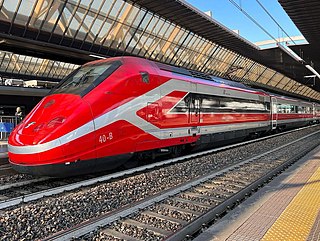
ETR 500 is a family of Italian high-speed trains built by AnsaldoBreda and introduced in 1993.

Frecciabianca is a high-speed train operated by Trenitalia, Italy's national train operator, and one of its Le Frecce brands, along with Frecciarossa and Frecciargento. Frecciabianca was introduced in 2011, replacing Eurostar City Italia. Frecciabianca trains operate at speeds up to 200 km/h (124 mph).

Bari Centrale is the main railway station of the Italian city of Bari, capital of Apulia. It is one of the most important railway stations in Italy, with an annual ridership of 14 million.

Le Frecce is the high-speed rail train category operated by Trenitalia in Italy.
